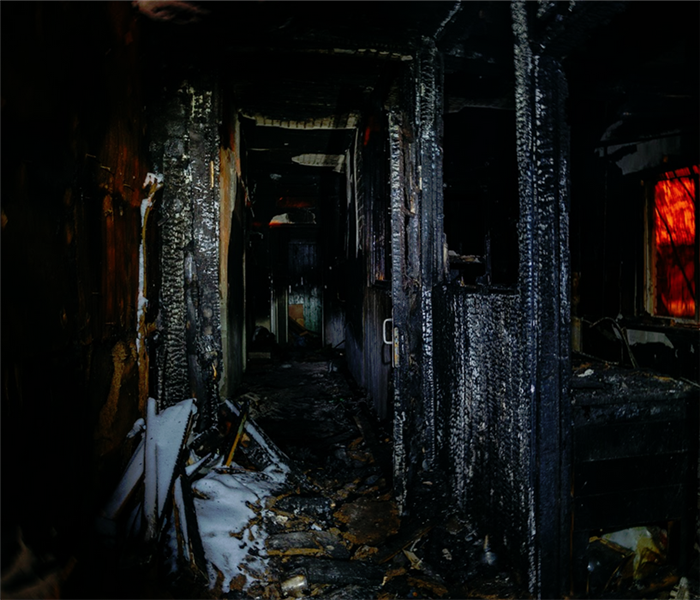How Can Restorers Work Without Harm or Injury in My Fire-Damaged Crossville Home?
8/9/2020 (Permalink)
 Fire damage can create hazardous situations for you and your family in your own home. Call SERVPRO for professional fire damage restoration.
Fire damage can create hazardous situations for you and your family in your own home. Call SERVPRO for professional fire damage restoration.
Even in the Chaotic Mess Created by the Flames, Smoke, and Soot, SERVPRO Delivers Premier Fire Restoration Results Safely in Crossville
When a home suffers fire damage, a long list of dangerous circumstances can confront workers arriving to set matters to rights. Homeowners in Crossville are sensible to be concerned about both their own and our team's safety during the restoration process. Safety hazards require identification, evaluation, and control. Fire damage restoration always includes hazards and dangerous conditions. With adherence to the industry's best practices, the effects of a fire disaster can resolve without injury or undesired health effects for either occupants or restorers.
Why Do Restoration Professionals Inspect Every Fire Damage Site with an Open Mind?
Probably the most dangerous attitude a fire damage restoration worker at your Crossville residence can hold is to think they know what dangers exist without an inspection. Although many general safety concerns are the same across sites, each house's attributes impact how the safety risk plays out. Our project managers take the pre-planning safety inspection very seriously. They look for safety risks such as:
- The configuration of the electrical and other utility lines/systems
- The presence of hazardous materials such as asbestos or lead paint
- The category of the water used for firefighting still standing inside the house or absorbed into structures or contents
- The air quality in space that needs fire mitigation, remediation, and restoration services
- The weakening of supporting structures because of charring, corrosive residues, or water damage, including overhead risks
- The growth of mold or other pathogens because of fire-related water damage
Does the Fire Restoration Work Stop Because of the Safety Risks?
SERVPRO managers and technicians do not shy away from hazardous conditions. Instead, they educate themselves about how the safety risk can be controlled so that we can restore the fire damage, returning your Crossville home to preloss condition. Homeowners can foster a safe environment by sharing pertinent information with the restorers and learning about the proposed project plan. We work closely with you to establish a secure worksite, communicating clearly and completely expectations for our work crew and you and your family.
What Are Some Examples of Actions that Promote Safety During Fire Restoration?
Organizing the work site
- Clear delineation of equipment, tool, and product storage areas (equipment and products can harm you if misused)
- Using signs or barriers to create a perimeter around the workspace (preventing the chance of injury to your loved ones)
- Consistent clean up of work area after work sessions (minimizing avoidable safety lapses like slipping, tripping, spilling)
- Sort debris from restorable materials, but get homeowner and insurance carrier acquiescence before disposal)
Identifying Hazards Occupants Should Avoid
Your loved ones and you are not adequately protected from contaminated air, water, and toxic residues, and should stay out of active work areas. Ask about the reasons partial evacuation is recommended if you are confused or concerned.
Implementation of Controls
Fire damage restoration is most successful when performed immediately and completed quickly. Our technicians thus must control the environment to get the needed tasks done. Here are some ways our restoration team manipulates the surroundings to stay safely on task. Here are some considerations:
- Elimination or Substitution—Can we sidestep the safety hazard or use a safer way to achieve the desired result?
Example: shut down the electricity if wiring is damaged or in the way near where work needs completion
- Engineering—Can we alter the conditions to reduce the hazard?
Example: use a negative pressure air scrubber to reduce airborne particulates in the work area
- Proactive and Administrative Efforts—Can we prepare and train workers to take safety precautions? Will scheduling work at certain times help?
Example: enroll managers and technicians in the Institute of Inspection, Cleaning and Restoration Certification (IICRC) before sending them out on fire damage restoration jobs
- Personal Protective Equipment (PPE)—Can we shield workers from exposure to the hazards through the use of head-to-toe PPE?
Do My Family, and I Need to Evacuate Our Home During Fire Restoration?
The answer to this question varies with the situation. We pledge to do everything possible to create an area within your home where your family can thrive while we restore surfaces and clean up debris. Sometimes it is simply too dangerous to remain in your fire-damaged home. Our commitment is to work closely with you and your insurance company to make the safest decision. Compromised air quality, exposure to the elements when exterior building materials suffered damage, and weakened structural integrity are all part of the equation.
Strict adherence to safety best practices keeps your loved ones, you, and our workers from harm while SERVPRO of Cumberland, Morgan & White Counties completes fire damage restoration. Line up our services by calling (931) 250-5333 even before the firefighters wrap up their tasks.





 24/7 Emergency Service
24/7 Emergency Service